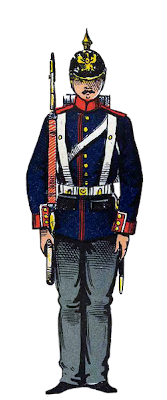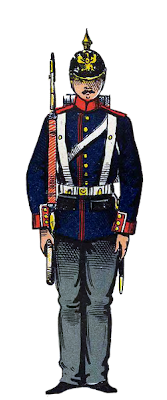|
 |
 |
|
Königreich Preußen |
|
|
|
errichtet aus die Stamm-Bataillone
Landwehr-Bataillon Spandau/
Landwehr-Bataillon Treuenbrietzen/
Landwehr-Bataillon Postdam/
20. Landwehr-Regiment
│ |
errichtet aus die Stamm-Bataillone
Landwehr-Bataillon Neu-Ruppin/
Landwehr-Bataillon Prenzlau/
Landwehr-Bataillon Havelberg/
24. Landwehr-Regiment
│ |
| 1860: |
I. Bataillon/
II. Bataillon/
Füsilier-Bataillon/
20. kombiniertes Infanterie-Regiment
│ |
I. Bataillon/
II. Bataillon/
Füsilier-Bataillon/
24. kombiniertes Infanterie-Regiment
│ |
| 1860: |
7. Brandenburgisches Infanterie-Regiment (Nr. 60)
│ |
8. Brandenburgisches Infanterie-Regiment (Nr. 64)
│ |
| 1861: |
7. Brandenburgisches Infanterie-Regiment Nr. 60
│ |
8. Brandenburgisches Infanterie-Regiment Nr. 64
│ |
| 1864: |
(Friedrich Heinrich Albrecht von Preußen (* 1809; † 1872))
│ |
(Friedrich Karl Nikolaus von Preußen (* 1828; † 1885))
│ |
| 1871: |
Deutsches Reich |
|
│ |
│ |
| 1872: |
(unbesetzt)
│ |
│
│ |
|

│ |

│ |
| 1885: |
│
│ |
(unbesetzt)
│ |
| 1889: |
Füsilier-Bataillon umbenannt in III. Bataillon
│ |
Füsilier-Bataillon umbenannt in III. Bataillon
│ |
| 1889: |
Infanterie-Regiment „Markgraf Karl“
(7. Brandenburgisches) Nr. 60
(Karl Friedrich Albrecht von Brandenburg-Schwedt (* 1705; † 1762))
│ |
Infanterie-Regiment „General-Feldmarschall Prinz Friedrich Karl von Preußen“
(8. Brandenburgisches) Nr. 64
(Friedrich Karl Nikolaus von Preußen (* 1828; † 1885))
│ |
| 1890: |
│
│ |
(Luise Margarete Alexandra Viktoria Agnes von Preußen (* 1860; † 1917))
│ |
|

│ |

│ |
| 1891: |
(Paul Stanislaus Eduard von Leszczynski (* 1830; † 1918))
│ |
│
│ |
| 1893: |
IV. Bataillon als Halb-Bataillon errichtet
│ |
IV. Bataillon als Halb-Bataillon errichtet
│ |
| 1897: |
IV. Bataillon abgegeben an Infanterie-Regiment Nr. 171
│ |
IV. Bataillon abgegeben an Infanterie-Regiment Nr. 151
│ |
| 1917: |
│
│ |
(unbesetzt)
│ |
| 1918: |
(unbesetzt)
│ |
│
│ |
| 1919: |
aufgelöst
|
aufgelöst
|
| 1921: |
|
|





